
There are many different types of heavy equipment that can be found on a construction jobsite. Like tools in a toolbox, each piece of machinery fulfills a specific role. Depending on the size and scope of the project, some or all of these machines may be used. It is important to have the right equipment for the job, as it makes work faster and more efficient. In this post, we will break down thirteen of the most common pieces of machinery and their general applications.
1. Bulldozer
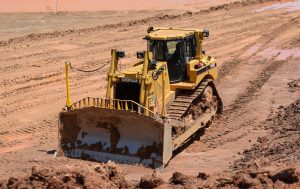
Bulldozers, also called track-type tractors and crawlers, are track-driven machines with large blades on the front used to move materials around a jobsite. A dozer can move materials such as debris, dirt, rocks, sand, snow, and more. Depending on the intended use, a dozer’s blades can either be edgeless and straight, curved, or some combination.
The tracks help to distribute the weight of the machine over a large area, preventing it from sinking into muddy or sandy ground. This allows bulldozers to operate in areas that wheeled machines may not be able to.
2. Excavator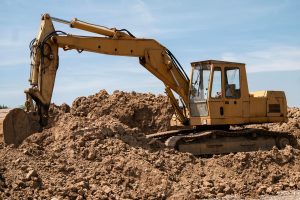
Primarily used for digging and material removal, excavators consist of a cabin (where the operator sits) and a long articulating arm with a bucket at the end. The cabin and arm assembly are mounted on a platform capable of rotating 360°, allowing the operator to work on all sides of the machine. Excavators are typically track-driven, but wheeled versions also exist. Excavators come in a variety of sizes to accommodate any jobsite or application.
At the end of the arm, there is a coupling device allowing other attachments to be connected for a variety of other applications, including: demolition, forestry, drilling, and much more. The arm and its functions rely on a hydraulic system to operate.
3. Loader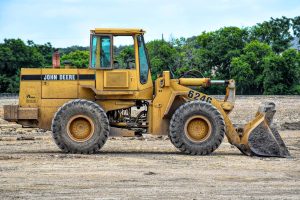
Loaders are tractors with front-mounted buckets useful for moving and loading materials onto trucks, railroad cars, conveyor belts, and more. Materials can include dirt, rocks, asphalt, raw or recycled materials, woodchips, demolition debris, logs, etc.
While a loader’s general use is quite straightforward, there are different attachments, sizes, and designs for a variety of applications. There are both wheel and track loaders, which utilize buckets or other attachments, such as stump grinders and asphalt cutters.
As a result of these variations, there a number of different names for loaders:
- Front/Front-end Loader
- Wheel Loader
- Skid-Steer
- Swing Loader
- Tractor Front Loader
- Bucket Loader
4. Backhoe Loader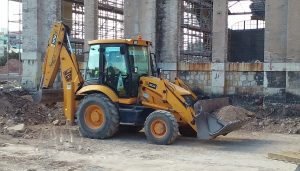
A combination loader and excavator, the backhoe is a wheeled tractor with an articulating arm and bucket mounted on the back and a wider bucket for loading on the front. While the articulating arm has considerably less range of motion than an excavator, the overall combination design makes it a more flexible machine.
The wheel-driven design allows it to move faster than a track-driven machine over smooth and firm surfaces. The arm typically sits closer to the ground on a backhoe, making it suitable for excavating below the machine level.
5. Dump Truck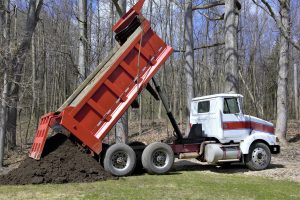
Capable of carrying large amounts of material in the open bed of the truck, dump trucks are valuable in transporting loads to, from, and around the jobsite. Most dump trucks raise their bed, hinged at the rear of the truck. and open their tailgate in order to dump the material behind the vehicle. Some trucks tilt the body onto its side, placing the material to the left or right of the vehicle. There are even bottom dump trucks, which consistently release material from the bottom of the bed, useful for spreading gravel or grain. These actions are performed by hydraulic systems.
Some dump trucks are rigid, with the cab and body both sitting on the same fixed chassis. Other trucks have the body attached just behind the cab at a point of articulation. Both rigid and articulated trucks can tow additional trailers that are also capable of carrying large amounts and dumping independently.
6. Grader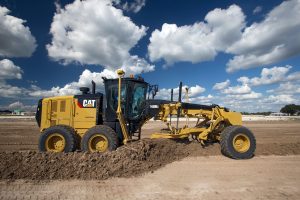
Commonly referred to as motor grader or road grader, these machines have long and narrow blades, known as moldboards. These blades are rotatable and have a cutting edge on the bottom to help cut and move terrain, creating a flat surface during the grading process. Though typically used for road building, many graders have optional attachments for the rear of the machine, expanding their possible applications.
7. Paver
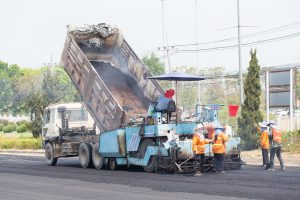
Pavers are asphalt laying machines used in road construction. Pavers have a feeding bucket that is continuously filled with asphalt or concrete by dump trucks. The paver then distributes the material evenly across the leveled surface using dispersion augers. It then uses a hydraulic cylinder to slightly compact the material and create a solid and stable surface. A compact roller is required to create further compaction.
8. Compactor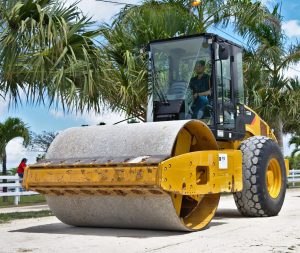
There are a few different kinds of compactors, including plate and roller compactors. Plate compactors are typically maneuvered by hand, though there are plate compactor attachments able to be used on excavators and other machines. Plate compactors use heavy, vertically vibrating plates to compact and level surfaces with repetitive movements. There are also hand-operated compactors with smaller footprints than plate compactors, called rammers, which operate using a piston.
Compact rollers, also called drum rollers or road rollers, are much larger and used for smooth and level material for roadways. The rollers are extremely quick and effective at flattening surfaces. The operator sits atop the vehicle, propelled by either one roller in the front and wheels in the rear, or just a pair of rollers. Rollers can either be smooth, or padfoot, which is covered in textured bumps. Smooth rollers work better for more coarse materials, while padfoot rollers are better for stickier or fine-grained soils.
9. Scraper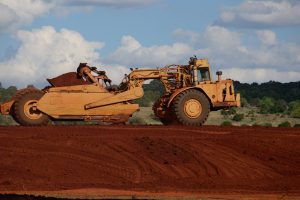
Wheel tractor-scrapers are used for earthmoving. Their long horizontal blades scrape material off of the ground and place it into the hopper in the rear of the scraper. The blade can be raised or lowered, and the hopper can also be raised and closed in order to transport the collected material. There are different types of wheel tractor-scrapers, including elevating, open bowl, push-pull, and tandem scrapers.
10. Aerial Lift
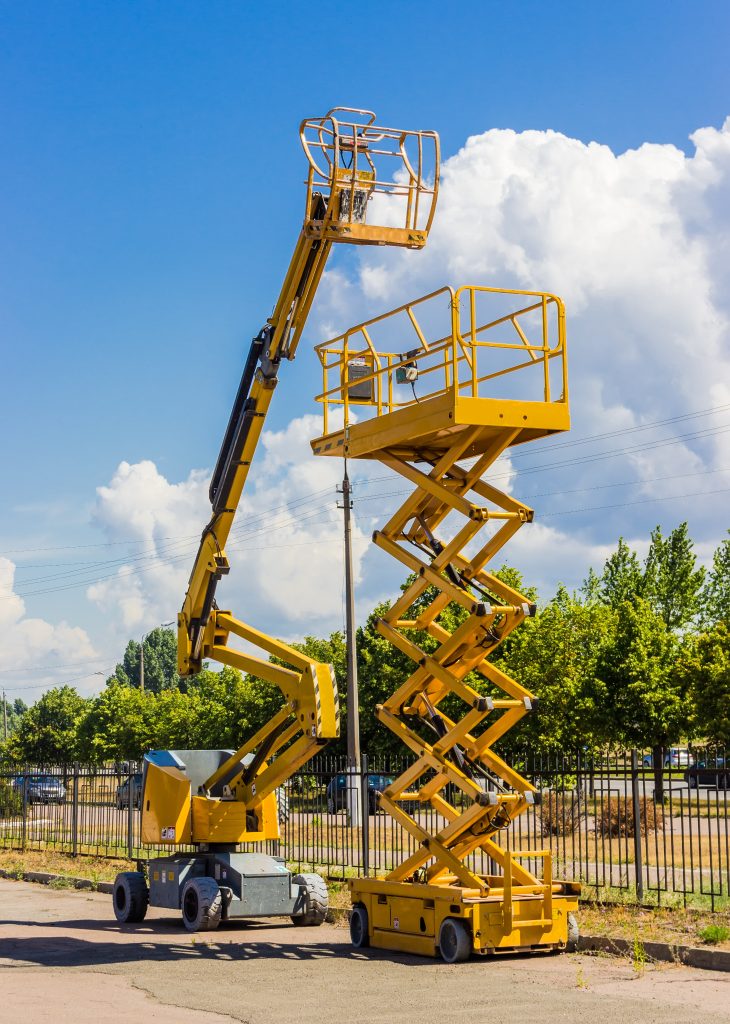
There are a few varieties of lifts that could be found on a construction site. Boom lifts, also called basket cranes or cherry pickers, have that baskets at the end of an articulating arm, allowing workers to reach elevated areas. There are also scissor lifts, consisting of a work platform on top of a series of crossed beams and struts, capable of expanding and contracting to raise and lower the platform. Not exclusive to construction, these lifts can be useful in a variety of situations. Some lifts are telescoping while others are articulating. Lifts can carry multiple workers at a time, depending on the size of the basket or platform.
11. Off-Highway Truck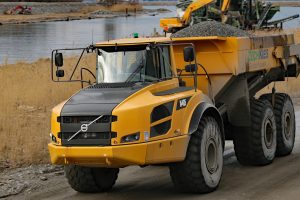
Off-highway trucks are a type of dump truck that offers heavy-duty hauling power. Off-highway trucks can transport larger loads than traditional dump trucks and are typically found in mines, quarries, and large-scale construction sites. Efficiency and power are the strengths of off-highway trucks. Some can even haul multiple dump buckets in order to increase efficiency.
12. Forklift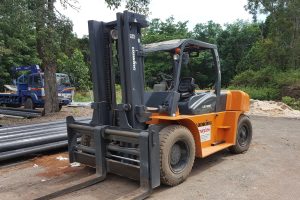
Forklifts are used on jobsites and around warehouses to transport large items across short and medium distances. Useful for unloading materials off of flatbed trucks and staging them, forklifts come in a variety of sizes to suit the items they will be transporting. Forklifts can be either propane- or battery-powered, while the lifting mechanisms are hydraulics.
13. Telehandler
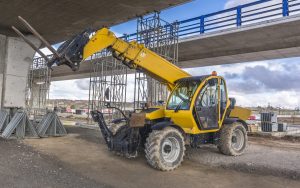
Telescopic handlers, also called telehandlers, teleporters, or reach forklifts, are machines capable of hoisting loads to higher elevations. Typically fitted with pallet forks at the end of the telescoping boom, telehandlers are useful for placing loads onto rooftops or other elevated areas. A variety of attachments can be fitted to the end of the boom, including buckets, winches, and more depending on the intended use.
Your Global Parts Resource
At Iron Wing Sales, we have parts for all of your heavy equipment needs. We carry a large inventory of genuine OEM and USA-made aftermarket heavy equipment parts. Our parts are in-stock and ready to ship now in order to help you minimize downtime. Take a look at our heavy equipment parts inventory, or search by part #, category, or manufacturer. For further assistance, contact us at: sales@ironwingsales.com or 216-912-9089.

